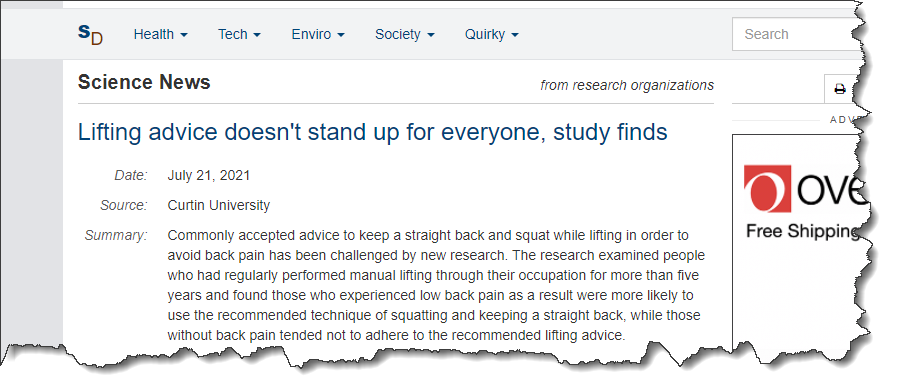
If you’re picking up heavy objects like this, you’re doing it wrong

Story-At-a-Glance
Matt Cook here, and I’m sure you’ve heard the old adage: lift with your knees, not your back…
It’s supposed to protect your back from injury and spread the weight more evenly through your legs.
But what if this advice was actually completely WRONG?
What if it was actually causing MORE pain and MORE back injuries?
Next time you go to lift something heavy, do it like THIS — not like this…
—-Important Message About Joint Pain—-
This one elemental powder works better than ibuprofen
Sore joints, bad knees, swollen ankles…
It’s easy to pop an ibuprofen and call it a day, but these treatments really aren’t good for you…
Ibuprofen hurts the gut lining, it hurts the kidneys, it hurts the liver.
Taking 2 or 3 or 6 a day may numb the pain temporarily — but it’s destroying your health even faster.
Instead, you can use one simple elemental powder that is natural and safe.
And it treats this chronic pain even better than ibuprofen.
Most importantly, this elemental powder makes the pain go away — permanently.
———-
Why lifting with your knees and not your back is dead wrong
I’m sure you’ve heard the advice to “bend at the knees and keep a straight back when lifting.”
Sometimes people describe it as “squat and keep your back straight.”
Usually the aim is to keep you from bending at the waist to pick things up.
That advice is given everywhere — I’ve heard parents say it to their kids.
I know it’s said in workplaces, and there is even training done on this “proper lifting technique” sometimes.
It turns out that the “proper technique” that everyone tells you is the right way to lift is probably really bad advice.
Now… I’ve got to tell you that when I read this particular study I was shocked.
I mean, we’ve heard this advice over and over again from everywhere I can think of.
I don’t think anyone even really questioned it, until now.
Which is why it’s important to question everything, and base as many of your health decisions as possible on data.

Curtin University studied this “tried and true” advice of bending at the knees and keeping your back straight when lifting.
They looked at a group of people who had been lifting in their work related activities for at least 5 years.
What they found was crazy…
People who used the commonly accepted lifting technique of bending at the knees and keeping their backs straight actually had MORE pain than those who used other techniques.
The research examined people who had regularly performed manual lifting through their occupation for more than five years and found those who experienced low back pain as a result were more likely to use the recommended technique of squatting and keeping a straight back, while those without back pain tended not to adhere to the recommended lifting advice.
That means that the advice these people (and everyone else) is given actually can make back pain WORSE.
Whoa.
Nothing like doing what you are “supposed” to do and getting the exact opposite results that are promised.
The researchers had the study participants perform repeated 100 pound lifts using 2 differently weighted boxes.
While they were lifting the researchers were observing and measuring what the study participants were doing.
“While both groups lifted using a more comparable technique at the end of the 100 lifts, the low back pain group still demonstrated a tendency to perform a slower and more squat-like lift throughout the task.
The bonkers thing about this is that people are often blamed for their back pain because they were lifting something “wrong.”
But it very well may be that the “right” way to lift something heavy isn’t what we’ve been taught!
“Common assumptions that people who experience low back pain during lifting do so in a way that is ‘incorrect’ were not supported by our research and this raises questions about current advice regarding ‘safe lifting’.
I think even the researchers were surprised by the results.
“These findings are the opposite of what is expected to occur according to existing advice on correct lifting techniques.”
I told you that I was surprised by this study, but not as surprised as you might think.
There’s a ton of “common advice” out there that seems like it’s based in science, but it’s really a bunch of hogwash.
The only way to know for sure is to get data to back up common pieces of advice and let the data guide you.
—-Important Message About Getting Stronger Muscles—-
Extreme anabolic growth: Huge muscle growth when you pop this in your mouth…

Believe it or not, popping one little bite size snack in your mouth can trigger your body to begin extreme anabolic muscle growth.
I call it an “exercise” but it isn’t really. Yet it will boost your gym gains.
And yes, waist size gets firmer… and your chest and thigh muscles get better defined…
It works by boosting important male androgens in the body, which naturally increases testosterone…
And this is where the magic begins — youthful T production triggers what I call extreme anabolic growth…
Some older guys even discover that yes, they have ab muscles, even a six pack.
Why does it work and how do you do it?
———-

